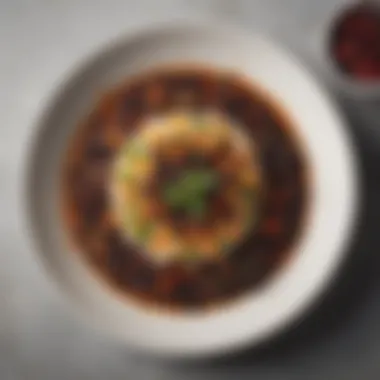Mastering Dried Black Beans: A Cooking Guide


Intro
Dried black beans serve as a fundamental ingredient in various cuisines around the world. Their versatility, rich flavor, and impressive nutritional profile make them a popular choice among home cooks and professional chefs alike. Cooking dried black beans not only enhances their flavor but also brings out their texture, contributing to a wide range of dishes.
In this guide, we will delve into essential aspects of cooking dried black beans effectively. You will learn how to select the best beans, prepare them properly, and explore various cooking methods. Additionally, we will examine the nutritional benefits of incorporating black beans into your diet, allowing you to understand why they are a staple food in many households.
Whether you are a novice or a seasoned cook, this comprehensive resource aims to equip you with the knowledge and techniques required for achieving perfectly cooked black beans every time.
Understanding Dried Black Beans
Understanding dried black beans is essential for anyone interested in elevating their cooking skills. These beans are versatile and provide numerous health benefits. By taking the time to understand their nutritional profile and culinary uses, one can enhance not only personal cooking experiences but also create dishes that appeal to a variety of tastes.
Nutritional Profile
A deep look into the nutritional profile of dried black beans reveals their importance in any diet.
Vitamins and Minerals
Dried black beans are rich in vitamins and minerals. They contain notable amounts of iron, magnesium, and folate. Iron helps in the formation of hemoglobin, while magnesium supports various biochemical reactions in the body. Folate is essential for DNA synthesis and crucial during pregnancy. These nutrients contribute significantly to overall health, making dried black beans a favored choice in nutrition.
Protein Content
Another key aspect of dried black beans is their impressive protein content. They provide a substantial amount of protein per serving, which is vital for muscle repair and growth. This makes them an excellent choice for individuals looking to improve their protein intake without relying on animal sources. Unlike some plant-based proteins, black beans are also packed with essential amino acids, which enhances their overall nutritional value.
Fiber Benefits
Fiber is a significant feature of dried black beans. They are high in dietary fiber, which aids in digestion and helps maintain a healthy gut. High fiber consumption is associated with lower cholesterol levels and improved blood sugar control. This makes black beans beneficial not just from a dietary perspective but also for long-term health. Including them regularly in meals can support overall well-being.
Culinary Uses
Beyond their health benefits, dried black beans are versatile in culinary applications. They feature prominently across many dishes, emphasizing their global significance.
Traditional Dishes
Traditionally, dried black beans have been used in various cuisines. In Latin America, they are a staple ingredient, often found in dishes like feijoada, a hearty black bean stew. The rich, earthy flavor enhances the complexity of these dishes, making them not just nutritious but also satisfying. Integrating them into traditional recipes preserves cultural flavors while offering a healthier option.
Modern Applications
In modern cooking, dried black beans have found their way into innovative culinary creations. Chefs and home cooks alike utilize them for salads, tacos, and grain bowls. Their adaptability means they can easily blend with a range of flavors. This versatility makes black beans a contemporary favorite, suitable for many dietary preferences.
Vegetarian and Vegan Recipes
For those following vegetarian or vegan diets, dried black beans are a popular choice. They can replace meat in many recipes, providing necessary protein without animal products. Dishes like black bean burgers or bean salads offer hearty, satisfying meals. The distinct flavor adds depth to vegetarian and vegan recipes, allowing for creativity in plant-based cooking.
Selecting Quality Dried Black Beans
Selecting quality dried black beans is a crucial step in achieving great results in your cooking journey. The quality of the beans can significantly impact the flavor, texture, and nutritional value of your final dish. This section will discuss where to buy dried black beans and what specific features to look for. The right choices ensure that the beans cook evenly and provide the desired taste and mouthfeel.
Where to Buy
Local Grocery Stores
Local grocery stores often have a variety of dried beans available, including black beans. These stores offer convenience as they are usually located in residential areas. The key characteristic of local grocery stores is accessibility. Most shoppers can quickly run to their nearby store without needing to travel far or deal with shipping times.
In these stores, you can frequently find packets that feature beans from various regions. However, the selection may be limited compared to specialty markets. It's also essential to check the packaging dates as older stock can lead to longer cooking times and less satisfying results.
Specialty Markets
Specialty markets are another excellent source for high-quality dried black beans. These stores usually focus on organic or gourmet products. The key advantage of shopping at specialty markets is the availability of unique varieties of black beans that may not be found elsewhere.
One distinct feature of specialty markets is their commitment to quality. They are often more meticulous about storage conditions, which helps preserve the beans' freshness and flavor. You may find beans that have been harvested more recently, which can positively affect cooking times and taste.
However, these markets can be pricier than local grocery stores. Buyers sometimes need to weigh the cost against the quality and uniqueness of the beans.
Online Retail
Online retail options for dried black beans have surged in popularity. Websites like Amazon or health-focused online stores provide a vast range of brands and types. One significant characteristic of online retail is the convenience of ordering from home.
You can read customer reviews, compare different brands, and often find organic options that may not be available locally. However, a disadvantage is the potential for shipping delays. Additionally, you cannot physically inspect the beans before purchase, which may lead to uncertainty about quality. It's advisable to select reputable sellers and check return policies.
What to Look For
Color and Size
The color and size of dried black beans are fundamental indicators of quality. High-quality beans typically have a rich, deep black color, signaling freshness. The beans should be uniform in size, indicating even growth. When beans are too small or contain shades of brown or gray, they may be older and could cook inconsistently. Selecting beans with a consistent color and size ensures a better cooking experience and final dish.
Texture and Aroma
Texture and aroma play a vital role in determining the quality of dried black beans. When you sift through the beans, they should feel firm with a slight sheen. If they are brittle or overly dry, they may have been stored for too long. The aroma should be pleasant and earthy; a musty smell might indicate spoilage. This characteristic ensures that you start your cooking with beans that are not only edible but will also impart a rich flavor to your meals.


Packaging and Labeling
Finally, the packaging and labeling are essential aspects to inspect. Beans should be sealed in opaque, durable plastic or paper bags that protect against light and moisture. Labels should include harvest dates or expiration dates. Knowing the specific origins can help in selecting beans that meet your culinary preferences. Good packaging protects the integrity of the beans while also providing consumers with important information that aids in choosing quality products.
*Selecting quality dried black beans can enhance your cooking experience significantly. Always make thoughtful choices when purchasing to guarantee the best results in your recipes.*
Through careful selection of where to buy and what to look for, you can ensure that your cooking with dried black beans becomes a rewarding and enjoyable process.
Preparing Dried Black Beans for Cooking
Preparing dried black beans properly is essential for achieving optimal flavor and texture. The way beans are prepared before cooking can dramatically influence their final results. This section highlights crucial elements such as sorting and rinsing, as well as soaking options that set the foundation for a successful cooking experience.
Sorting and Rinsing
Removing Debris
The process of removing debris is a necessary step in preparing dried black beans. Beans come from the earth, and sometimes they carry small stones or dirt along with them. Ensuring that these foreign items are taken out is important for safety and cleanliness. Removing debris not only guarantees that you are cooking pure beans but also helps avoid any unpleasant crunches in your dish. This aspect is simple yet vital, making it a beneficial practice for anyone cooking dried beans.
Advantages of removing debris include peace of mind knowing your meal is safe to eat. However, it may take a few extra minutes. Overall, any time spent on this preparation step is time well invested in achieving quality cooking results.
Rinsing Techniques
Rinsing dried black beans is the next important step. Rinsing helps wash away any residual dirt from the sorting phase. It also removes some of the oligosaccharides, which are indigestible carbohydrates that can result in digestive discomfort. This rinsing technique not only promotes cleanliness but also enhances the overall dining experience.
Using cold water during rinsing allows the beans to stay firm, which is a key characteristic desired in many recipes. The unique feature of rinsing is that it can be done quickly, often in under a minute. However, one disadvantage is that not all the oligosaccharides might wash away, which varies from batch to batch. Nonetheless, rinsing beans should always be a customary practice during the preparation phase.
Soaking Options
Overnight Soaking
One effective method for preparing dried black beans is overnight soaking. This process involves immersing the beans in water for several hours, typically eight or more. By allowing the beans to soak, you encourage them to absorb moisture, which can cut down the cooking time significantly. This method is highly recommended for those who plan ahead and gives the beans a chance to soften before actual cooking begins.
The key feature of overnight soaking is the gentle way it hydrates the beans, making them easier to digest. A potential disadvantage is needing to remember to soak them in advance, which may not suit spontaneous cooking plans. However, the benefits of improved texture and flavor far outweigh this minor inconvenience.
Quick Soaking Method
For those with little time, the quick soaking method serves as an efficient alternative. Initial boiling of the beans in water for about two minutes, followed by letting them sit in the hot water for an hour, also serves to hydrate the beans. Although this option is faster, it still allows for some texture improvement before cooking.
A notable characteristic of the quick soaking method is its efficiency. It is beneficial for individuals short on time but still desiring well-cooked beans. However, while it is a faster process, it may not yield the same softness and flavor complexity that overnight soaking does. Being aware of these trade-offs can help you make the right choice based on your cooking needs.
Cooking Techniques for Dried Black Beans
Understanding different cooking techniques for dried black beans is essential to mastering their preparation. Each method influences flavor and texture in unique ways. Choosing the right technique can enhance the bean's inherent qualities, making them a delicious ingredient in many dishes. This section will explore three primary methods: stove top, slow cooker, and Instant Pot. Each method has its advantages depending on time constraints and desired results.
Stove Top Method
Required Tools
For cooking dried black beans on the stove, you need a good quality pot. A heavy bottom pot is ideal, as it distributes heat evenly. Some people prefer using a Dutch oven for its heat retention properties. Both choices ensure that the beans cook uniformly without burning. Hosever, a standard pot works well for most cooks. Just make sure it has a lid to cover during cooking.
Process Overview
Cooking beans on the stove is straightforward. Start by adding soaked beans and enough water to cover them. Bring the pot to a boil, then reduce the heat to a simmer. Cover the pot and monitor the beans closely. You can add water as needed to keep the beans submerged. This method is popular for its simplicity and the ability to see the cooking process, but it does require attention to prevent overcooking.
Cooking Time Considerations
Cooking time varies based on the age of the beans and how long they soaked. Generally, stove top cooking takes about 1 to 1.5 hours. It is beneficial to check the beans periodically until you achieve your desired softness. Overcooking can lead to mushy beans, which can be undesirable, especially in salads or other dishes where texture matters.
Slow Cooker Method
Preparation Steps
Using a slow cooker is an excellent choice for those who prefer set-it-and-forget-it cooking. Start by rinsing and sorting the beans as described in previous sections. You should then add them to the slow cooker with enough liquid to cover the beans. Additional seasonings can be added at this stage for flavor development over the cooking period. The convenience of this method allows for cooking while you focus on other tasks.
Recommended Settings
When slow cooking, it’s usually best to set the device on low for 6 to 8 hours or on high for about 3 to 4 hours. This versatility allows for flexibility in your schedule. The low setting tends to enhance flavors over time, making it a favorable choice for those looking for a deeper taste.
Cooking Duration
Slow cookers require a longer cooking time but offer the advantage of infusing flavors while causing minimal disruption to your day. You do not need to check the beans frequently, as the slow cooker maintains steady temperatures. However, the key characteristic here is patience; take the time needed to enjoy the full flavor of your beans.
Instant Pot Method
Pressure Cooking Guidelines
The Instant Pot offers a modern solution for those short on time. This method uses pressure cooking to significantly reduce cooking time. To prepare, simply add soaked beans, water, and any desired seasonings to the pot. Lock the lid in place and set the cooking function to beans. This is popular due to its efficiency and consistent results.
Time Management
With the Instant Pot, cooking dried black beans can take as little as 30 to 40 minutes under pressure. This time frame makes it an attractive option for busy individuals. It’s crucial to account for the time it takes for the pressure to build and release, which can add more time to the overall process.


Safety Considerations
Using an Instant Pot is generally safe, but there are some things to keep in mind. Ensure the sealing ring is properly placed and check the steam release valve before cooking. This method allows you to prepare nutritious meals quickly; however, improper usage can lead to safety hazards. Always follow the manufacturer's guidelines to ensure safe and proper operation.
Enhancing the Flavor of Cooked Black Beans
Enhancing the flavor of cooked black beans is crucial for transforming a simple ingredient into a delicious main or side dish. Black beans tend to have a subtle taste; hence, the right spices and add-ins can make a significant difference to the overall eating experience. Proper seasoning not only improves the flavor but also elevates the nutritional value, creating a more wholesome meal.
Spices and Seasonings
Common Spices
Common spices are fundamental in unlocking the depth of flavor in black beans. Spices like cumin, paprika, and chili powder contribute warmth and a hint of earthiness. Their aromatic profiles can enhance the natural richness of the beans. For those looking to add complexity, smoked paprika can introduce a pleasant smokiness that complements the beans.
One key characteristic of these spices is their ability to infuse flavor during the cooking process. Unlike fresh herbs, spices do not lose much of their essence when subjected to heat. This feature means they are ideal for generating a robust flavor base that can hold up in various dishes.
However, it is important to use spices judiciously. Their intense flavor can easily overpower, so one should balance them according to personal preference and the overall dish being created.
Fresh Herbs
Fresh herbs provide a bright contrast to the earthiness of cooked black beans. Cilantro is a popular choice, offering a fresh, slightly citrusy flavor that livens up the dish. Other options include parsley and green onions, adding freshness while complementing the beans well.
The unique feature of fresh herbs is that they should be added towards the end of cooking or as a garnish. This timing ensures they retain their flavor, color, and nutrients, making them a valuable addition to a variety of bean-focused recipes.
While fresh herbs can enhance flavor nicely, they may not have the robust presence that some cooks desire compared to dried spices. Thus, the use of herbs might require additional considerations of balance, particularly in flavoring.
Salt and Acidity Balance
Salt and acidity are essential components in enhancing the flavor of black beans. Salt serves to amplify other flavors, making it a crucial step in the cooking process. A thoughtful addition of salt at the right time can emphasize the beans' natural taste without making them overly salty.
Acid, on the other hand, typically from ingredients like lime juice or vinegar, can brighten up a dish. This addition not only contrasts the richness of the beans but can also enhance overall flavor depth. It is a strategy often employed to elevate the taste of many savory dishes.
The balance of these elements is delicate. Too much salt can mask flavors, while too much acidity can render the dish sour. This necessitates careful planning during preparation to achieve a harmonious outcome.
Adding Additional Ingredients
Onions and Garlic
Onions and garlic form a classic aromatic base that can significantly elevate the flavor of cooked black beans. The sweetness of onions, when cooked, pairs exceptionally well with the savory notes of the beans. Similarly, garlic contributes a pungent depth that rounds out the flavor.
Commonly used in a variety of culinary traditions, both ingredients are versatile and easy to incorporate. They can be sautéed together before adding the beans, allowing their flavors to meld. However, one should exercise caution with garlic, as overcooking can lead to bitterness.
Peppers and Tomatoes
Peppers and tomatoes are excellent companions for black beans. Bell peppers can add crunch and sweetness, while tomatoes lend moisture and acidity. This combination results in a well-rounded dish with diverse textures. When combined, they contribute to the creation of rich sauces or stews.
However, it is vital to consider that tomatoes can alter the cooking time of black beans. They require a careful balance to ensure the beans are cooked perfectly without becoming mushy.
Meats and Proteins
Incorporating meats and other proteins can also enhance overall flavor profiles. Bacon, sausage, or chicken can add depth and richness, delivering a savory essence to the dish. Meat-based broth can be used as a cooking liquid to add an extra layer of flavor that complements the beans.
While these additions can create a hearty dish, they also shift the dish away from being purely plant-based, which may be a consideration for those looking to create vegetarian or vegan meals. Choosing the right protein based on dietary preferences is essential.
In summary, enhancing the flavor of cooked black beans involves a thoughtful approach to spices, seasonings, and additional ingredients. The right balance can elevate the beans from a simple staple to a star component in a delicious meal.
By considering these aspects, cooks can master the art of utilizing black beans effectively, making them a delightful addition to numerous culinary creations.
Storing Cooked Black Beans
Storing cooked black beans properly is essential for maintaining their flavor and nutritional value. This process ensures that you can enjoy your beans later without losing texture or taste. When stored correctly, cooked black beans can be a convenient and nutritious option for various meals. It also helps reduce food waste, making your cooking more efficient and sustainable.
Refrigeration
Storage Containers
Choosing the right storage containers is crucial when it comes to keeping cooked black beans fresh. Glass or BPA-free plastic containers are top choices because they do not absorb odors and can be sealed tightly. One of the key characteristics of these containers is that they allow for visibility, making it easier to see what’s inside without opening them. This is beneficial as it helps reduce spoilage by reminding you of what you need to use.
A notable feature is that glass containers are microwave-safe, allowing for quick reheating. While they might be heavier than plastic, their durability makes them a long-term investment. On the downside, they can be pricier, but many find the advantages outweigh the costs.
Duration Guidelines
Duration guidelines provide clarity on how long cooked black beans can be safely stored in the refrigerator. Typically, they should be consumed within three to five days to ensure optimal taste and safety. This guideline is beneficial as it encourages efficient meal planning and consumption.
One unique aspect of duration is that if beans start to develop an off smell or mold, they should be discarded immediately. The advantage of having clear duration guidelines is it helps you monitor your food, reducing the risk of spoilage and waste.
Freezing
Preparation for Freezing
Proper preparation is essential for freezing cooked black beans. Before freezing, allow them to cool to room temperature and portion them into servings. This approach makes it easier to thaw only what you need later. The key characteristic of preparing beans is to avoid over-filling the bags or containers. Expanding space as they freeze can cause breakage.


A unique feature of this method is implementing various portion sizes to accommodate different meal needs. This method is very advantageous, as it keeps beans tasty for up to six months when stored properly.
Thawing Methods
Thawing methods play an important role in how cooked black beans maintain their texture after freezing. The safest approach is to transfer them from the freezer to the refrigerator a day before use. This slow thawing process helps preserve the beans' quality.
Alternatively, you can use the microwave for quicker results. This method is beneficial where time is limited and can be done while keeping an eye on the heat to ensure even thawing. The unique feature here is efficiency, allowing you to enjoy your beans with minimal waiting period. However, it is essential to monitor the beans closely as rapid heat can cause uneven warming.
Remember, correctly storing and utilizing cooked black beans can enhance your meal preparation and prevent food waste.
Common Mistakes to Avoid
Cooking dried black beans can be a rewarding experience, but it is not without its pitfalls. Understanding and avoiding common mistakes can lead to significant improvements in both flavor and texture. This section highlights three key errors: overcooking, neglecting seasoning, and inadequate soaking. Recognizing these mistakes helps maintain the integrity of the beans while enhancing culinary results.
Overcooking
Overcooking is a frequent error made by both novice and experienced cooks. When black beans are cooked for too long, they become mushy and lose their desirable texture. The ideal black bean should be tender yet firm enough to hold its shape.
To avoid this, monitoring the cooking time is crucial. Whether using a stovetop, slow cooker, or Instant Pot, it’s beneficial to check the beans periodically. Remember that different cooking methods can lead to varying times. For example, stovetop beans may cook in about 1 to 1.5 hours, while pressure cooking in an Instant Pot typically takes 20–30 minutes.
Using a timer can prevent overcooking and ensure beans are cooked perfectly. Regularly taste testing during the process can help gauge doneness accurately.
Neglecting Seasoning
Seasoning plays an essential role in enhancing the overall flavor profile of cooked black beans. Many cooks overlook this aspect by adding too little or sometimes no seasoning at all. Without salt and other seasonings, even perfect beans may taste bland and unappealing.
To ensure rich flavor, consider adding salt at the right moment. It is recommended to wait until the beans are nearly cooked before adding salt as it can impede the cooking process if added too early. Other seasonings, such as cumin, garlic, or bay leaves, can elevate the taste significantly.
Even a simple infusion of herbs or spices can transform a basic bean dish into something memorable.
Inadequate Soaking
Soaking dried black beans is a step that should not be ignored. Many novice cooks either skip this step or do not soak long enough. Soaking helps reduce cooking time and improves digestibility, as it allows the beans to hydrate.
There are two primary methods for soaking: overnight soaking and quick soaking. Overnight soaking involves submerging the beans in water for about 8 hours, which yields the best results. The quick soak method, though less effective, involves boiling water and letting the beans sit for an hour. However, skipping soaking entirely can lead to longer cooking times and tougher beans.
"A little attention to detail can make all the difference in the kitchen."
By recognizing and correcting these errors, cooks of all skill levels can master the art of preparing dried black beans.
Utilizing Leftover Beans
Utilizing leftover beans not only reduces food waste but also maximizes culinary creativity. Black beans, with their versatile texture and flavor, can be easily repurposed into various dishes that fit both casual and formal dining situations. Making the most of your leftover beans can also lead to healthier meals, as these beans are high in nutrients. Focusing on practical methods ensures you won't waste this valuable ingredient.
Creative Recipe Ideas
Salads and Wraps
Salads and wraps present an ideal way to use leftover black beans. They add a hearty element that complements fresh vegetables, grains, and various dressings. The texture of black beans enhances the overall mouthfeel of salads, allowing them to stand out. Incorporating beans into wraps also provides an easy, on-the-go meal option that is both satisfying and nutritious.
- Nutritional Benefit: Adding black beans increases protein and fiber levels.
- Ease of Preparation: Simply mix with leftover veggies and top with dressing.
- Uniqueness: Black beans offer a unique contrast to crisp salad greens.
However, it is important to consider the balance of flavors in salads. Adding too many dense ingredients might overshadow the beans' natural flavors.
Soups and Stews
Soups and stews are classic methods for utilizing leftover beans. They provide a perfect setting for flavors to meld together while maintaining the integrity of the beans. Soups allow for creativity with various spices and vegetables, making each dish unique while enhancing the beans' contribution to the overall flavor profile.
- Easy to Prepare: Simply add to broth with seasonings and additional ingredients.
- Comfort Food Appeal: Many people find soup to be a comforting choice.
- Versatility: Beans can adapt to different cuisines, from chili to minestrone.
You should watch for the cooking time. Overcooking can lead to mushy beans, which may not provide the desired texture in your soup or stew.
Purees and Dips
Using leftover black beans as purees and dips is another excellent application. They deliver a creamy texture that works well in spreads and dips. Black bean dip is both flavorful and satisfying, making it a favorite at gatherings.
- Healthy Snack Option: Purees can replace heavier fat sources in dips.
- Customization: Easily tailored with various spices or additional ingredients for unique flavors.
- Effortless Preparation: Can be blended quickly in a food processor.
While purees offer a smooth texture, they can lack texture variation compared to whole beans, so you may want to add back some whole beans for contrast.
Storage Solutions
Labeling and Organizing
Labeling and organizing your leftover beans is fundamental for maintaining freshness. Clear labels can help you track the date of preparation, ensuring you use them within a safe time frame. This practice is essential for effective meal planning.
- Organization: Keeps your refrigerator or freezer tidy and easy to navigate.
- Waste Reduction: Reduces the chances of forgetting leftovers, thus cutting down on waste.
Consider using color-coded labels to distinguish different ingredients or types of leftovers. This small effort can save time when selecting meals.
Freezer-Friendly Options
Freezing leftover beans is an advantageous technique to prolong their usability. You can freeze beans in portions, allowing for quick access anytime.
- Convenience: Frees you from daily cooking commitments while still offering ready-to-use ingredients.
- Longevity: Extends shelf life considerably, allowing beans to last months if stored correctly.
However, be mindful of texture changes after freezing. Beans may not retain their original firmness; thus, they may be best suited for cooked applications rather than whole usage in salads.















